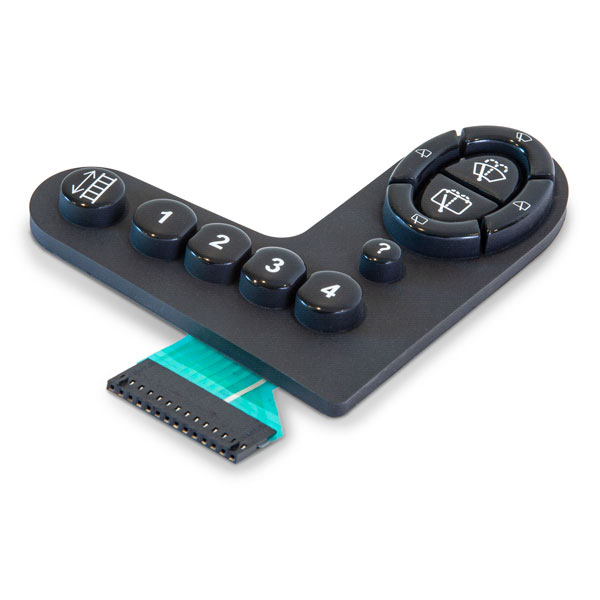How Membrane Switch Technology is Revolutionizing User Interfaces
How Membrane Switch Technology is Revolutionizing User Interfaces
Blog Article
Understanding Membrane Layer Changes: The Trick to Dependable and durable Controls
What Are Membrane Switches?
Membrane switches are an innovative option in the world of individual interface modern technology, integrating functionality and layout flawlessly. These devices work as an interface in between users and digital systems, integrating several components right into a compact format. Generally built from versatile, thin layers of materials, membrane layer buttons are developed to reply to touch, making it possible for customers to communicate with machinery and digital devices properly.
The main aspects of a membrane button consist of a published circuit layer, graphic overlay, and a spacer layer that stops unexpected activation. The visuals overlay can be customized to reflect brand name identification or customer choices, enhancing appearances while guaranteeing functionality. Membrane layer switches are generally used in different applications, including clinical devices, consumer electronics, and commercial devices, owing to their durability and resistance to environmental factors such as moisture and dust.
One of the key advantages of membrane switches is their capability to hold up against damage, making them excellent for high-traffic environments. In addition, they are lightweight and call for marginal room, enabling ingenious designs in product development. Generally, membrane switches over represent a effective and useful selection for modern electronic interfaces, weding technology with user-centric design principles.
Just How Membrane Changes Job
The operation of membrane layer switches hinges on a basic yet reliable mechanism that equates individual input right into digital signals. When a user presses the switch, the top layer warps, permitting a conductive element in the circuit layer to make contact with a matching conductive pad on the underside of the graphic overlay.
The layout of membrane switches can differ, however they frequently include domes or responsive elements to provide feedback to the individual, improving the general experience - membrane switch. The products made use of in membrane layer buttons, such as polyester or polycarbonate, add to their resilience and resistance to environmental elements, including wetness and dust. Moreover, the published circuits are commonly enveloped, which shields them from damage with time.
Benefits of Membrane Buttons

Furthermore, membrane switches are understood for their longevity. Constructed from robust materials, they are view website immune to dirt, moisture, and physical wear, which significantly extends their lifespan compared to conventional mechanical switches. This sturdiness makes them especially appropriate for high-traffic atmospheres and applications needing durability.
One more considerable advantage is the simplicity of cleaning and maintenance. The smooth surface of membrane switches reduces dust build-up and is commonly resistant to spills, making them suitable for setups that need regular sanitization.
Furthermore, membrane switches offer a structured account, bring about a thinner layout that can be incorporated right into different gadgets without adding mass. This function not just boosts the visual appeal however additionally adds to an extra ergonomic product style.
Applications of Membrane Buttons
Straightforward and flexible, membrane buttons discover applications across a vast array of markets, consisting of clinical gadgets, consumer electronic devices, and commercial tools. In the clinical area, these switches are integral to gadgets such as diagnostic tools, patient monitoring systems, and infusion pumps, where dependability and ease of cleansing are crucial. Their capability to hold up against harsh environments and preserve capability makes them ideal for such applications.

In customer electronic devices, membrane layer buttons are used in items like microwaves, washing machines, and remotes - membrane switch. Their smooth style enables user-friendly user interfaces, enhancing the total individual experience while offering resilience and resistance to use and tear
Industrial tools also gains from membrane switches, especially in control panels for machinery and automation systems. These buttons supply defense against dirt and wetness, guaranteeing consistent efficiency in tough settings. In addition, their adjustable features discover here enable makers to tailor them to details functional demands, boosting performance and performance.
Picking the Right Membrane Change
When picking a membrane switch, it is vital to consider numerous variables that affect performance and suitability for details applications. The primary considerations consist of ecological conditions, tactile responses, longevity, and design specs.
First, assess the operating setting; buttons subjected to wetness, chemicals, or extreme temperatures require certain materials to make sure longevity and functionality. Next off, review the requirement for tactile responses. Depending upon individual interaction, some applications may gain from a tactile feedback to confirm activation, while others might favor a non-tactile layout for visual factors.
Resilience is another crucial element; membrane layer switches ought to be designed to withstand constant use, effects, and abrasion. Make certain the chosen button can withstand the expected lifecycle, particularly in high-usage situations.

Conclusion
To conclude, membrane switches over function as crucial parts in the layout of dependable and visit homepage sturdy control systems across various sectors. Their small layout, incorporated with robust building and customizable functions, boosts customer communication while guaranteeing longevity sought after environments. The flexibility of membrane switches over allows for tailored remedies that meet particular operational demands, strengthening their significance in modern-day technology. As sectors remain to develop, the relevance of integrating effective membrane layer switch solutions can not be overstated.
Membrane layer switches stand for an important aspect of contemporary interface design, blending functionality with strength in numerous applications.Membrane layer switches are a sophisticated remedy in the world of customer interface technology, incorporating capability and style effortlessly. Typically built from flexible, thin layers of products, membrane layer buttons are designed to react to touch, enabling customers to communicate with equipment and digital devices properly.
The design of membrane layer switches can differ, however they frequently integrate domes or tactile components to give responses to the user, improving the overall experience.In final thought, membrane switches over offer as necessary elements in the design of sturdy and dependable control systems across numerous sectors.
Report this page